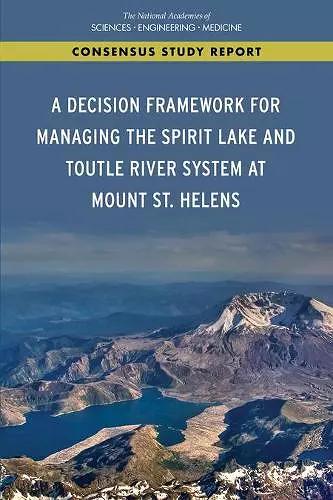A Decision Framework for Managing the Spirit Lake and Toutle River System at Mount St. Helens
Division on Earth and Life Studies author Division of Behavioral and Social Sciences and Education author Board on Earth Sciences and Resources author Water Science and Technology Board author Committee on Geological and Geotechnical Engineering author Board on Environmental Change and Society author National Academies of Sciences, Engineering, and Medicine author Committee on Long-Term Management of the Spirit Lake/Toutle River System in Southwest Washington author
Format:Paperback
Publisher:National Academies Press
Published:29th Apr '18
Currently unavailable, and unfortunately no date known when it will be back

The 1980 eruption of Mount St. Helens in southwest Washington State radically changed the physical and socio-economic landscapes of the region. The eruption destroyed the summit of the volcano, sending large amounts of debris into the North Fork Toutle River, and blocking the sole means of drainage from Spirit Lake 4 miles north of Mount St. Helens. As a result of the blockage, rising lake levels could cause failure of the debris blockage, putting the downstream population of approximately 50,000 at risk of catastrophic flooding and mud flows. Further, continued transport of sediment to the river from volcanic debris deposits surrounding the mountain reduces the flood carrying capacity of downstream river channels and leaves the population vulnerable to chronic flooding.
The legacy of the 1980 eruption and the prospect of future volcanic, seismic, and flood events mean that risk management in the Spirit Lake Toutle River system will be challenging for decades to come. This report offers a decision framework to support the long-term management of risks related to the Spirit Lake and Toutle River system in light of the different regional economic, cultural, and social priorities, and the respective roles of federal, tribal, state, and local authorities, as well as other entities and groups in the region. It also considers the history and adequacy of characterization, monitoring, and management associated with the Spirit Lake debris blockage and outflow tunnel, other efforts to control transport of water and sediment from the 1980 and later eruptions, and suggests additional information needed to support implementation of the recommended decision framework.
Table of Contents- Front Matter
- Summary
- 1 Introduction
- 2 Regional Setting
- 3 Institutional Setting: Developing a Common Understanding
- 4 Natural Hazards
- 5 The Engineered Landscape
- 6 Choosing a Decision Framework and Identifying the Decision Problem
- 7 Identifying Decision Objectives and Alternatives
- 8 Decision Consequences and Trade-Offs
- 9 Applying the Decision Framework
- References
- Appendix A: Biographical Sketches of Committee Members
- Appendix B: Meeting Agendas
- Appendix C: Board Rosters
- Appendix D: Congressional Request Letter <
ISBN: 9780309464444
Dimensions: unknown
Weight: unknown
336 pages